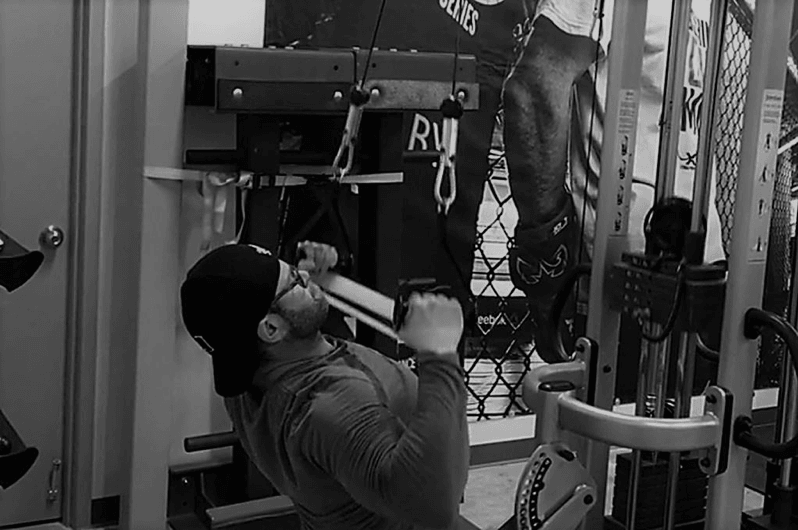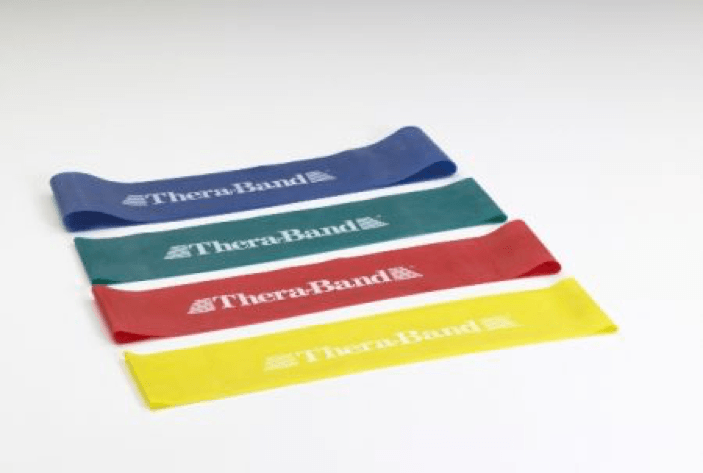Knowledge
Special Exercises Series – No.12 Building A Muscular Back With The Spread Apart Lat Pulldown
Articles, Muscle gain, Strength and performance

Special Exercises Series - No.12 Building A Muscular Back With The Spread Apart Lat Pulldown
The spread-apart lat pulldown is one of my go-to exercises to improve rear deltoids, rhomboids and lats development, as well as the mind-muscle connection with these muscles.
My good friend, bodybuilding and strength coach, Florian Bianchi showed me this exercise and it is the best lat pulldown variation that I’ve done to grow more muscle on my back. Florian is the guy I trained with when I got into my best shape for the THIBARMY photoshoot. He has worked with many champion bodybuilders as well as pro athletes, and he now runs the XPN Center, where I personally train.
By his own admission, his greatest strength is developing legs and back. It’s his specialty if you want to call it that. The spread apart lat pulldown certainly falls into that category and is an amazing tool to improve not only back muscularity but also the mind-muscle connection with your back.
If your back muscularity is your weak link, or if you have trouble feeling your back when training it; the spread apart lat pulldown is definitely an exercise you need to include in your training program.
I also recently wrote an article on my 10 best tips for increasing muscle mass in your back, and highly recommend that you take a look at that one too! Dr. Rusin’s Pulling Law …And 10 Back Training Tips by Thib
Before we get started here’s what the spread apart lat pulldown looks like.
What is the spread apart lat pulldown good for?
- It greatly increases rear deltoids and rhomboids activation when doing a lat pulldown. This obviously turns it into a much more complete back exercise.
- It increases the mind-muscle connection with your entire upper back; you will feel everything back there to a much greater extent than during regular lat pulldown variations (which I personally never really felt myself). Improving the mind-muscle connection is the first step towards fixing a lagging muscle group.
- It allows you to get much stronger muscle tension in your back without having to use a very high amount of weight. This reduces stress on the shoulder that can occur if you keep loading lat pulldowns.
- The lower weight used, as well as the focus on spreading the band apart, makes it a lot less likely that you will overuse your biceps to do the work. Remember the principle of first tension: the muscle firing first in an exercise is the muscle that will receive the most stimulation. Spreading the band allows you to fire the back first (rhomboids and rear delts), shifting most of the tension onto it rather than the arms.
For more info on the principle of first tension you can go watch my video on this topic: Muscle Recruitement Series – No. 2 The Principle of First Tension
- You can further increase the recruitment of the rear deltoids by holding the bottom position for two seconds, trying to actively stretch the band as much as possible. Developing strong and functional rear deltoids is one of the most important thing you can do to improve shoulder health; which will help you press bigger weights with much less injury risk. You can never have too much rear delts emphasis in your training, as I point out in this article: Ten Secrets of Shoulder Training
How is the spread apart lat pulldown performed?
- You will need a lat pulldown station with independent dual pulleys; this is pretty much the norm in most commercial gyms nowadays so it shouldn’t be a problem. Place a single handle on both pulley attachment.
- Place a therapeutic band around your wrists. Many gyms now have these bands, they can otherwise be bought at many sporting goods stores. You can order them online: Thera-Band Products

- Set-up as you would for a regular pulldown with the dual handles, using a neutral grip. I suggest leaning back slightly, maybe 15-20 degrees, which will further facilitate recruiting of the rear deltoids and rhomboids.
- Initiate the lat pulldown by simultaneously pulling the handles down and spreading the band apart. This action continues for the whole concentric range of motion, meaning that the band is spread more and more as you are pulling lower.
- Pause for two seconds in the bottom position, actively trying to spread the band even more.
- Return to the starting position slowly. The eccentric (returning the weight back to the starting position in this case) is what builds the most muscle. Furthermore, training the rear deltoids, rhomboids and whole upper back to contract hard eccentrically is what will reduce shoulder injuries because that is how these muscles are contracting when you are pressing heavyweights.
- Hold the stretched position for a second or two, while maintaining some tension on the band before you start your next rep.
Are there, any variations to the spread apart lat pulldown?
I use four other variations of this back exercise. The first one is simply a slight modification of the “regular” spread apart lat pulldown: the difference is that you actively try to keep the band spread apart when you return the handles up (back to the starting position). In other words, you try to maintain the same distance between both arms as you have in the lower position until you got back to the starting position. When you reach the top position, you can bring your arms closer together and start the next rep. This method is a killer for the rear deltoids and one of the best exercises you can use specifically to target that muscle.
The second variation is similar to the preceding one. The difference is that you stay spread apart for the whole set. In other words, start the set by pulling the band apart and pulling down. But once the band is spread apart you keep it wide for the duration of the set. This is the best variation to improve rear deltoid recruitment however it will also force you to use less weight so it won’t work as well to build the lats.
The third variation of the spread apart lat pulldown is even simpler: lean back further when doing the exercise. I don’t mean swinging with your lower back here. I mean using a torso angle of approximately 45 degrees and maintaining that position for the duration of the set. This emphasizes the rear deltoids and rhomboids more, but also slightly decreases the action of the lats. The original version is a better overall back builder, while this one is better for those two muscles.
Finally, you can use the same technique with the seated row (with independent dual handles), rowing toward your clavicle with the elbow pointing outward. This becomes a pure rear deltoid/rhomboid movement and the lats are taken out of the movement pretty much completely.
What do you need to avoid with the spread apart lat pulldown?
- Do not use momentum to pull the handles down; this means that you should do both the concentric (pulling) and eccentric (bringing back up) under control, even slowly. Remember, this exercise is as much about learning to contract all of your back muscles as it is to develop them, and it is much easier to work on maximizing contraction when going slower.
- Do not pull straight down and try to spread the band once you reach the bottom. For maximal effectiveness, you must initiate the lat pull down by simultaneously pulling down and spreading apart. Waiting until you reach the bottom to spread apart great diminishes the efficacy of the movement.
- Do not lose tension at the bottom. To get the most out of the spread apart lat pulldown, it is very important that you hold the tension for two seconds once you reach the bottom position. Actively trying to spread the band while you are holding the low position will greatly increase rear deltoids recruitment while keeping the lats under tension.
- Do not lose tension on the way up. You should maintain outward pressure as you go up. Remember that a great portion of the muscle stimulation from this movement comes from the eccentric portion.
What are the best loading parameters for the spread apart lat pulldown?
This is not an exercise that should be done with heavyweights. It is a constant tension exercise. Both the concentric (pulling) and eccentric (bringing back up) should be done slowly to maximize muscle tension and improve the mind-muscle connection.
The spread apart lat pulldown can serve three purposes:
a) as a muscle-building tool, in which case you should use sets of 8-12 reps with a fairly slow tempo (e.g. 2 seconds pull, 2 seconds hold in the bottom, 4 seconds to bring it back up). I normally do 4 sets and I like to do it early in my back workout to activate all the key muscles prior to doing heavier pulls.
b) as an activation tool prior to heavy bench pressing. I like to include the spread apart lat pulldown in my “warm-up” for heavy bench pressing along with band shoulders dislocates, DB external shoulder rotations and bottoms-up kettlebell press. For more info on these exercises, you can read about them in this article: Pain-Free High-Performance Pressing in 10 Minutes
In this case, I still use a slow tempo, I will actually make it even slower and hold the pause in the bottom for four seconds instead of two. For this purpose, I use the first spread apart lat pulldown variation I mentioned; the one where you maintain the arms spread apart on the way back up. I only do 2-3 sets of 6-8 reps, not close to failure. The goal is only to wake up the read deltoids and rhomboids, not to fatigue them so that they will support the prime movers during the heavy bench press.
c) as a pre-fatigue tool in a back superset. Even though I normally prefer to use an isolation exercise to pre-fatigue a muscle or group of muscles prior to the heavier movement, the spread apart lat pulldown can also be used. For example, I would do 8-12 reps of the spread apart lat pulldown, rest 15-30 seconds then do either barbell rows or chest supported rows, fairly heavy. 3-5 sets of this combination should be used.
Conclusion
Building a great back is complex because you can use all kinds of compensatory mechanisms. That’s why I prefer to rely heavily on mind-muscle exercises like the spread apart lat pulldown rather than on a ton of heavy work during which you don’t feel the tension on the right muscles. However, the better your mind-muscle connection becomes, the more effective the big heavy lifts will be. In that regard, exercises like the spread apart lat pulldown is not only a great training exercise, it’s an investment in future gains!
– CT